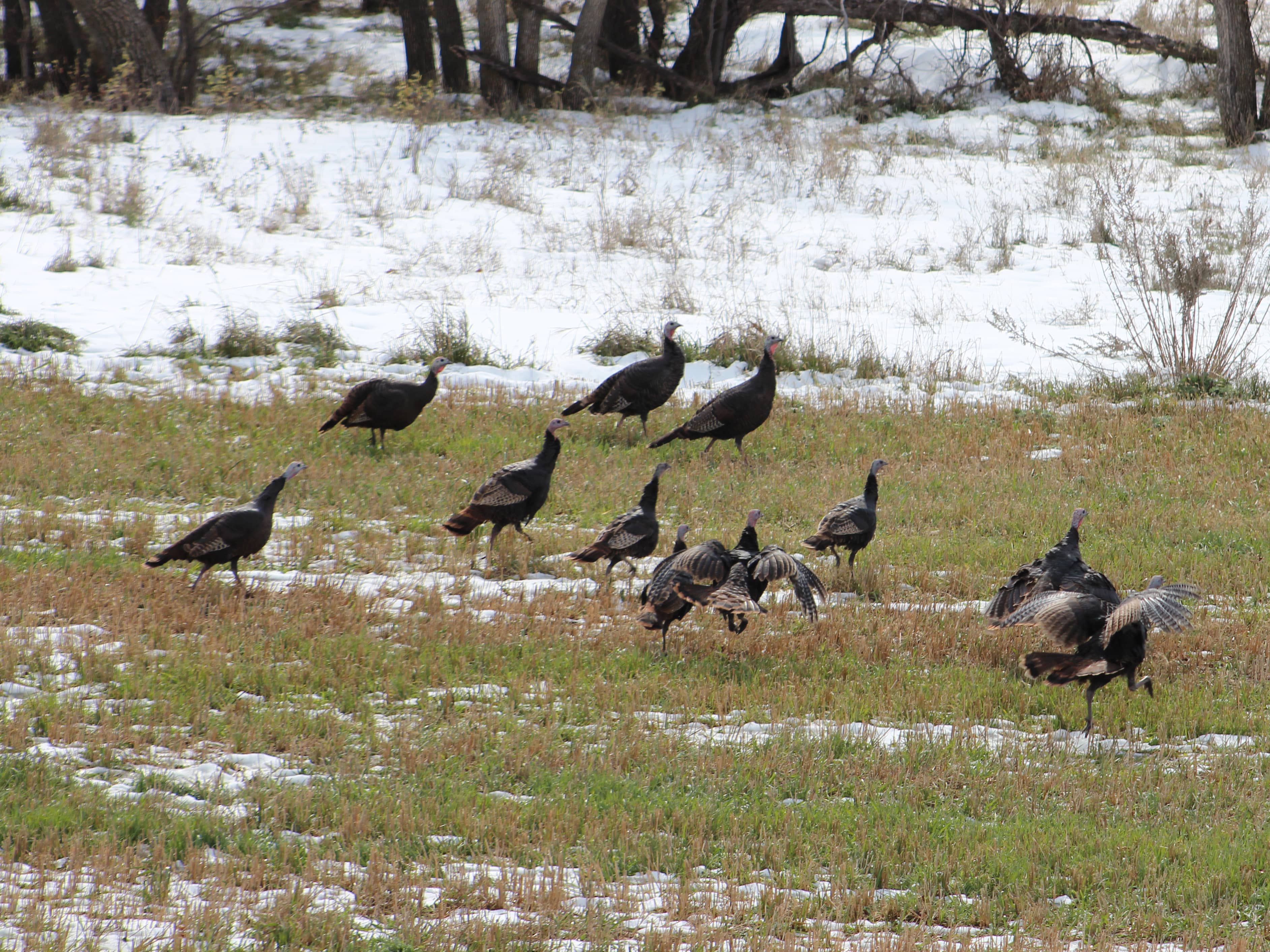
Spring Stroll. Wild turkeys make their way through the receding snow in the relative morning calm before spring gusts return. Knowing how the shift in winds can influence animal behavior will help with future hunting efforts.
By Nick Simonson
“It’d be a great day…if it wasn’t for the wind.”
If I had a nickel for every time I heard this, I’d have enough for a season’s worth of bait, but such is spring in the upper Midwest. The jet stream yaws and the days oscillate in turn: gusts from the south, gusts from the north, gusts from the east and then a chance for chilly rain or late season snow. Then it all repeats.
Even now as I write this with bright red lips chapped by the southeasterly breezes that blew in for the first afternoon of coaching the high school trap shooting season yesterday, I can hear the wind still rushing against the sliding glass door to the deck.
Looking out at the seven-day forecast, there’s not a six-hour stretch of daylight on the NOAA readout where the gusts drop below 10 mph and planning the first open water forays is limited to those early morning opportunities where they do. Wind is a given this time of year as the pattern shifts from cold weather to warm, and sometimes the gusts just can’t be avoided. But the impacts of those gales can be limited and learned from with a bit of planning, no matter the pursuit.
On the Water
Wind can make fishing challenging, especially the chill it brings, but on those days of first open water, target stretches of rivers that first and foremost, hold fish, but second, provide some protection from the gusts. Tuck in on the leeward side of a river when fishing early spring walleyes or trout to allow better casts and line management from both standard and fly gear.
Those spaces of shore which have thick vegetation or trees such as pines or dense brush (even without leaves) or steeper banks will provide a natural windbreak. There’s always a new angle to fish a certain stretch, whether from shore or boat, and adjusting to the wind can also provide new insight on how to approach the area.
Heavier lures are easier to cast and will help keep lines a bit tighter when searching for fish in spring winds. Consider upping jig weight and working an area while facing downwind with the rod tip near the water’s surface allowing for a tighter line and less bows created by gusts. Keep an eye on those spools as the line goes out and watch for loops or wind knots as gusts pull casts a bit further than normal and the line comes back to the reel with each turn of the handle.
In the Field
Those spring series of windy days provide insight into how popular game species behave in relation to the gusts as they rise, fall and shift. Yesterday morning on the drive out to the range, there was a brief period where the winds died off slightly.
All along the side of the road, birds seemed to be everywhere. Everything from returning robins to cocky rooster pheasants to wild turkeys were active, sizing up the situation, pecking out a few choice morsels from the nearby plantings in the semi-suburban stretch and generally enjoying a slight lull in the wind. Even a trio of whitetailed deer were out on a field edge in the comparative calm which extended into mid-morning. These events and sightings provide patternable cues for any hunter thinking about the turkey season to come in just a matter of days, or those thinking long-term as to animal activity in the fall. Make note of them in a journal as you would field experiences in October and November to get a better understanding of how animals, who generally avoid movement in the breezes, react (and how fast they do) when things settle down.
Finally, just as one rarely abandons a hunt simply due to the wind, know that all hunting situations are subject to some sort of aerial interference. Shooting trap or visiting the rifle range on a gusty day provides a bit of realism to the controlled environment. Have you ever seen a mourning dove fly straight?
Not likely.
They, along with other game birds, can juke and jive and ride the gusts in ways that leave us flummoxed in the field. A gusty day behind the trap thrower or on the sporting clays course in spring prepares us for the shifty conditions which return in fall. Even calculating the wind’s influence on a rifle bullet can help with field adjustments when that big buck is driven to defy the breezes during the rut and be on an all-out chase in front of your hunting position. On those days when the spring gusts impact shooting sports pursuits, know that you’ll be more than ready when the target isn’t painted orange.
You can curse the wind, you can share a pithy comment, but you can’t give up. Treat those gusts as a way to learn more about the fish and game pursued and use those windy days as times to test your skills and enhance them.
It’s likely that those lessons gleaned from the experience will make you a better angler and hunter with a greater understanding…of our outdoors.
